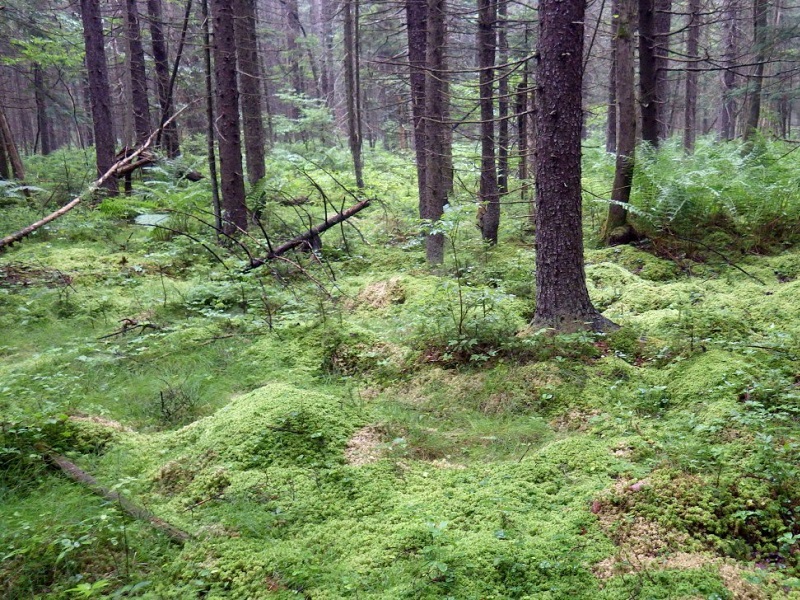 Past Efforts
Past Efforts
Terrestrial and Palustrine Plant Communities of Pennsylvania 2nd Edition represents the third approximation of plant communities for Pennsylvania. Plant communities of Pennsylvania were first published in draft form by the Pennsylvania Natural Heritage Program in 1983 by Tom Smith with major revisions in 1991 and again with minor revisions in 1994. The entire classification was re-done in 1999 for a DCNR Bureau of Forestry publication entitled Terrestrial and Palustrine Plant Communities of Pennsylvania by Jean Fike.
The focus of the Smith classification was the Natural Community, and community types ranged from broad definitions of habitats (e.g., Floodplain Swamp or Serpentine Barren) to more discrete types defined by the specific landform and soil characteristics (e.g., Oligotrophic Glacial Kettlehole Bog). Smith also included aquatic and subterranean communities. Smith's Natural Community concept was closer to an ecosystem approach where the individual plant communities are not the focus of classification but rather the focus is the entire landform-based ecosystem. For instance, Smith treated the unique suite of habitats found on serpentinite bedrock as a single unit - a Serpentine Barren - for classification and conservation purposes, rather than listing the many community types found there.
The Fike classification shifted to a Plant Community Concept using species and physiognomy (tree, shrub, herbaceous, etc.) per the International Vegetation Classification System (IVC) developed by NatureServe. In a plant community classification, the plant communities are defined by dominant species. In the Serpentine Barrens example above, each plant community is described and mapped as an individual unit and each has its own conservation status, rarity and quality ranks, and management needs. In Fike, these plant communities include: Serpentine Pitch Pine - Oak Forest; Serpentine Virginia Pine - Oak Forest; Red Cedar - Pine Serpentine Shrubland; Serpentine Grassland; Serpentine Gravel - Forb Community; and Serpentine Seep. It is common that a given Serpentine Barren will not contain all of these, and often, several other types that may exist more broadly are found. Fike addressed ecological systems, or groups, by describing Community Complexes - groups of communities occurring together in a given ecosystem, such as River Bed - River Floodplain Community Complex.
Terrestrial and Palustrine Plant Communities of Pennsylvania 2nd Edition builds upon the Fike text organizing the plant communities by species composition and physiognomy (tree, shrub, herbaceous, etc.). We have added to the Community Complex concept by identifying the Ecological Groups, which are categories composed of communities that are often found together on the landscape and respond similarly to similar ecosystem processes. Identifying Ecological Groups allows us to refer to Smith's Natural Community concept, and also link the Pennsylvania Community Types with NatureServe's Ecological Systems.
Since its creation in 1999, the Fike document has been used by DCNR and PNHP to classify, describe, and map state forest and park lands across Pennsylvania. These described community types provide a foundation for management activities on state, private, and federal lands in the state.
Terrestrial and Palustrine Plant Communities of Pennsylvania 2nd Edition is a significant update to Terrestrial and Palustrine Plant Communities of Pennsylvania (Fike 1999). Ecology, conservation, and management information not included in Fike is included in this edition. Both wetland (palustrine) and terrestrial plant communities are included in this revised classification; however, descriptions of terrestrial types are from Fike. As we refine and update the terrestrial component of the classification in 2012, the links to Fike types will be updated with new information. As with the original Fike classification, this version does not include vegetation types characterized by a high degree of direct human influence (e.g., roadsides, agricultural fields, lawns, forest plantations), nor does it include aquatic or subterranean communities.
The classification effort is ongoing. Our understanding of the patterns of variation in the natural world is constantly evolving. As we gather more information and come to better understand these patterns, the classification will be modified to reflect that understanding, as well as changes in Pennsylvania's ecology and vegetation over time. The living document allows us to provide the most up-to-date information on species composition, ecology, and management of these communities.
Terrestrial and Palustrine Plant Communities of Pennsylvania 2nd Edition is a product of PNHP, which is a partnership among the Department of Conservation and Natural Resources (DCNR), the Pennsylvania Game Commission (PGC), the Pennsylvania Fish and Boat Commission (PFBC), and Western Pennsylvania Conservancy. PNHP worked with the Pennsylvania Biological Survey (PABS) to form a Community Classification Standing Committee to provide peer review and assist in the process of developing and updating the Pennsylvania Plant Community Classification. The standing committee meets regularly to review existing types, nominate new types for inclusion in the classification, develop applications for the classification, and assist PNHP in developing plans for future community/ecosystem research.







